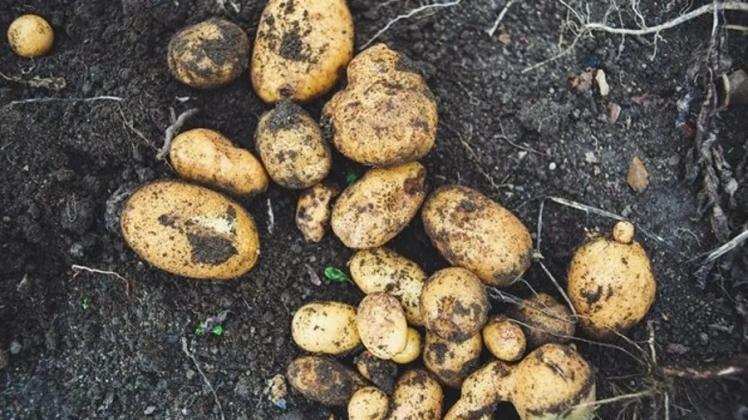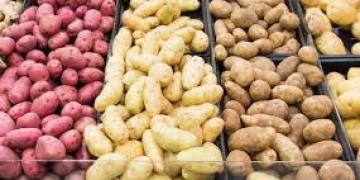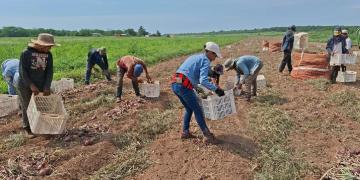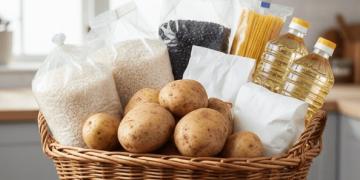China: ‘Beyond salty challenges’: The future of potato production in salt-affected regions
Researchers at Northeastern Agricultural University in Harbin, China studied the distribution of potato acreage in relation to salt-affected areas.

They also evaluated the development and use of salt-tolerant potato varieties. In addition, they reviewed progress in identifying the genes responsible for potato salt tolerance and their potential to address the challenges faced by potato growers. A research paper was published in the International Journal of Molecular Sciences in June 2023.
The article below is a summary of their findings.
Introduction
The potato is the fourth most important food crop in the world, with ploidy ranging from diploid to hexaploid, although diploid and tetraploid varieties are predominantly grown. These tubers are nutritional giants, with high levels of protein, starch, potassium, iron, and vitamin C — often surpassing many staple foods and vegetables.
Beyond direct human consumption, potatoes have a significant impact on animal feed, the food processing industry and the global economy. One of their remarkable attributes is their adaptability, particularly their resilience to cold and drought, which allows them to be grown in a variety of terrains.
Their central role in food security, especially in developing countries, cannot be underestimated. While the West has long consumed potatoes, their growing popularity in Asia and increased cultivation in Africa have increased their global importance.
For optimal growth, potatoes depend on nutrients in their tubers and thrive in organic-rich, well-aerated soils with a pH of 5.0–5.5. However, they struggle in saline soils, which limit their growth and yield. Research into salt tolerance is therefore essential for potential growth in saline regions.
Global potato area and consumption
Originating in the Andes Mountains of South America, potatoes have become popular around the world for their versatility and nutritional value. By 2014, more than 150 countries were growing the tuber. Between 2013 and 2020, the global area under potato cultivation will decrease, reaching 16,887.04 thousand hectares in 2020. Asia and Europe, with China and India in Asia and Russia and Ukraine in Europe, are the dominant regions in potato production.
In 2020, China accounted for 27.69% of the world’s potato area, producing 92.8 million tons, while India followed with 12.15%, producing 48.56 million tons. China, with a 400-year history of potato cultivation, has four major production zones. Although area decreased from 2013 to 2020, yields increased. Despite challenges such as adverse weather and policy changes, China’s potato production remains robust with higher yields expected in the future.
Current challenges with saline soils
By 2020, the FAO reports that more than half of the world’s 1.56 billion hectares of cropland, or 833 million hectares, will be affected by salinization, resulting in annual global economic losses of approximately $27.3 billion.
Countries such as Australia, Canada, the United States, India and especially China have significant amounts of salinized land. Salinized soils contain mainly Cl-, SO42-, Mg2+, Na+, K+ and Ca2+. The Northeast China Plain exemplifies the complex process of soil salinization; it faces strong winds, limited rainfall, and frequent freeze-thaw patterns in winter.
These natural conditions, combined with human activities such as river irrigation and uncontrolled grazing, intensify salt accumulation. This increasing salinization is reducing arable land, raising concerns about economic stability and food security, and underscoring the need for salt-tolerant crops.
Effects of Salt on Potato Growth, Physiology and Biochemistry
In agriculture, potatoes are particularly affected by salt stress, a major abiotic challenge. This stress causes marked changes in the physiology and appearance of the potato, culminating in reduced tuber quality and yield. While potatoes have some tolerance to salt, they aren’t completely resistant to its adverse effects. Salt stress is particularly damaging during the tuber-expanding stage, a time of high nutrient demand. Salty soils can lead to reduced seedling emergence and growth, and increased susceptibility to scab disease, which reduces the market value of the potato.
Soil conductivity is directly related to its salt content; higher conductivity signals unfavorable conditions for potato growth, including increased risk of seed rot and delayed germination. Elevated salinity negatively affects root development by inhibiting water uptake during the seedling stage. Salt stress results in fewer, yellowing leaves and reduced tuber formation in both size and number, leading to reduced overall crop yield.
Internally, salt stress increases sodium and chloride ion levels in potato plants, disrupting the natural ion balance. This influx of salt damages cell membranes and impedes the uptake of potassium, an essential ion for many plant enzymes. High salt levels also cause an increase in antioxidant enzymes to counteract elevated levels of reactive oxygen species (ROS). However, excessive salt can suppress these enzymes, inhibit CO2 fixation during photosynthesis, and lead to overproduction of ROS that can damage proteins, lipids, and DNA.
At the same time, increased chloride ions affect chlorophyll content and affect carbohydrate distribution, reducing starch content in tubers. Excess salt also disrupts protein metabolism, causing both a decrease in synthesis and accelerated breakdown. These changes contribute to a significant reduction in potato yield and quality.
Progress in identifying salt tolerance genes in potato
Advances in potato genome research
The potato has a complex autotetraploid genome that makes genetic improvement difficult. Although vegetative propagation ensures genetic stability, it increases susceptibility to viruses and pests. Conventional breeding has been challenging, driving a deeper understanding of the potato genome to advance molecular breeding.
The transition from tetraploid to diploid varieties is benefiting genomic research. In 2006, a dedicated group began to focus on diploid potato genomes. By 2011, 95% of the potato genome had been sequenced. Wild diploid potatoes, known for their disease resistance, face reproductive challenges with cultivated varieties.
In 2015, the genome of a wild diploid potato was published. Research into the self-incompatibility of diploid potatoes has identified genes to overcome this problem. By 2020, a detailed heterozygous diploid genome will be available to aid breeding. In addition, a tetraploid genome map was developed.
Potato salt tolerance genes and pathways
Plant hormones play a key role in plant growth and stress responses. Nine hormones help plants adapt to salt stress. Abscisic acid (ABA) is particularly important during salt stress because it reduces transpiration. Other hormones, such as salicylic acid, increase antioxidant production, while others inhibit growth but increase resistance. Some hormone pathways are still under investigation in relation to salt stress in potato.
Ca2+ in plant cells is essential for environmental stress tolerance. Salt stress causes a shift in Ca2+ concentration, which generates calcium signals. Calcium receptors then interpret these signals to activate salt stress-responsive genes. Among these receptors, calcium-dependent protein kinase (CDPK) and calmodulin protein (CaM) are important. The role of certain pathways, such as CBL/CIPK, is still under investigation in potato.
Genes determine plant responses to salt stress. Key genes such as SnPK play a role in the stress response. Overexpression of certain genes increases enzyme activity and other stress-resistant traits. The DWF4 gene, which is important for brassinosteroid synthesis, and certain ubiquitin-binding genes have been shown to be critical for improving salt tolerance.
Transcription factors, proteins that affect gene transcription, regulate plant responses to salt stress. In potato, important factors include ERFs, NAC, DREB/CBF, and others. These factors respond to salt stress, and overexpression of certain factors has been shown to increase salt tolerance.
Other plant defense mechanisms include protease inhibitors (PIs) and transporters. Overexpression of genes related to these mechanisms has shown increased salt tolerance. Research in potatoes is aimed at increasing salt tolerance, quality and yield. Genetic modifications involving specific genes show potential for improved potato quality and yield.
The use of multi-omics approaches is a recent advance in the study of potato salt tolerance.
Future Perspectives
Potato production in China’s saline and alkaline areas requires varieties with increased tolerance. Although some varieties are resistant to neutral salt, data on salt tolerance remain limited. Recent studies have investigated the salt-alkali tolerance of diploid potatoes and revealed a possible relationship between salt and alkali tolerance. However, understanding this relationship in tetraploid potatoes is unclear.
The combined stress of alkali and salt often reduces crop yield, highlighting the need to study the resilience of tetraploid potatoes under saline-alkali conditions. Previous research has focused primarily on gene expression and physiological changes associated with salt tolerance, neglecting the mechanisms behind these changes. Future studies should investigate the relationship between gene expression variation and differences in salt tolerance in potato germplasm, with the aim of developing more salt-tolerant varieties.
Source: Han, X.; Yang, R.; Zhang, L.; Wei, Q.; Zhang, Y.; Wang, Y.; Shi, Y. A Review of Potato Salt Tolerance. Int. J. Mol. Sci. 2023, 24, 10726. https://doi.org/10.3390/ijms241310726
Photo: Credit Markus Spiske on Unsplash
Fuente: https://www.potatonewstoday.com/2023/09/26/beyond-salty-challenges-the-future-of-potato-production-in-salt-affected-regions/




